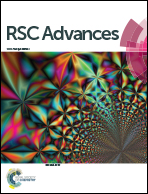Anion transfer across “anion channels” at the liquid/liquid interface modified by anion-exchange membrane†
Abstract
To mimic the anion channels in biomembrane, a novel strategy based on the membrane-modified liquid/liquid interface using anion-exchange membranes was firstly proposed to study simple ion transfer processes of highly hydrophilic anions at the modified liquid/liquid interface by employing voltammetric methods. Significantly, fascinating ion transfer phenomena were observed at the water/1,2-dichloroethane (W/DCE) interface modified by a homogeneous anion-exchange membrane, including the remarkable extension of the polarization window; well-defined transfer waves of some highly hydrophilic anions, such as sulfate and nitrite; and an amazing positive-shift of their transfer potentials. According to both ion-exchange membrane models, a new mechanism based on the sieving effect and pre-dehydration in combination with electrostatic effects dominantly induced by the gel phase of anion-exchange membrane on ion transfer reactions was preliminarily proposed to explain those fascinating ion transfer phenomena.


 Please wait while we load your content...
Please wait while we load your content...